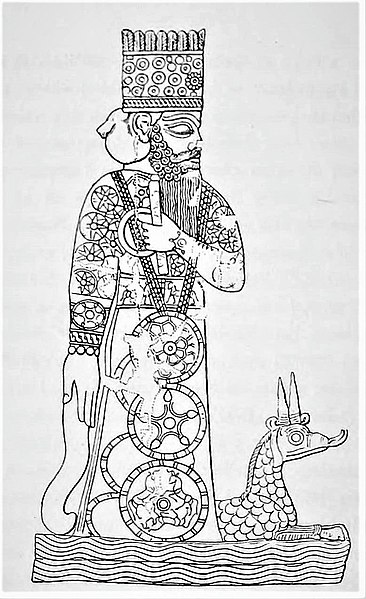Eber-Nari or Ebir-Nari (Akkadian), also Abar-Nahara (Aramaic) or Aber Nahra (Syriac), was a region of the ancient Near East. Translated as "Beyond the River" or "Across the River" in both the Akkadian and Aramaic languages, it referred to the land on the opposite side of the Euphrates from the perspective of Mesopotamia and Persia. In this context, the region is further known to modern scholars as Transeuphratia. Functioning as a satrapy, it was originally administered by the Neo-Assyrian Empire before being absorbed by the Neo-Babylonian Empire and then by the Achaemenid Empire. During the Greek conquest of Persia, Eber-Nari was, like the rest of the Achaemenid Empire, annexed by the Macedonian Empire of Alexander the Great. It was later dissolved by the Seleucid Empire, which incorporated it into Syria, along with Assyria.
Phoenicia, Sidon. Uncertain king. Circa 435-425 BC.
Coin of Mazaios, Satrap of Eber-Nari, Sidon, Phoenicia. Circa 353-333 BC.
Relief of a gift-bearing delegation, possibly Syrian or Ionian, at Apadana of Persepolis
The Neo-Babylonian Empire or Second Babylonian Empire, historically known as the Chaldean Empire, was the last polity ruled by monarchs native to Mesopotamia. Beginning with the coronation of Nabopolassar as the King of Babylon in 626 BC and being firmly established through the fall of the Assyrian Empire in 612 BC, the Neo-Babylonian Empire was conquered by the Achaemenid Persian Empire in 539 BC, marking the collapse of the Chaldean dynasty less than a century after its founding.
Stele of Nabonidus exhibited in the British Museum. The king is shown praying to the Moon, the Sun and Venus and is depicted as being the closest to the Moon.
Illustration of the inhabitants of Babylon deriding the Achaemenid king Darius I during the revolt of Nebuchadnezzar III in 522 BC. From the History of Darius the Great (1900) by Jacob Abbott.
Partial view of the ruins of Babylon in modern-day Iraq.
9th century BC depiction from a cylinder seal of the Statue of Marduk, Babylon's patron deity Marduk's main cult image in the city.







